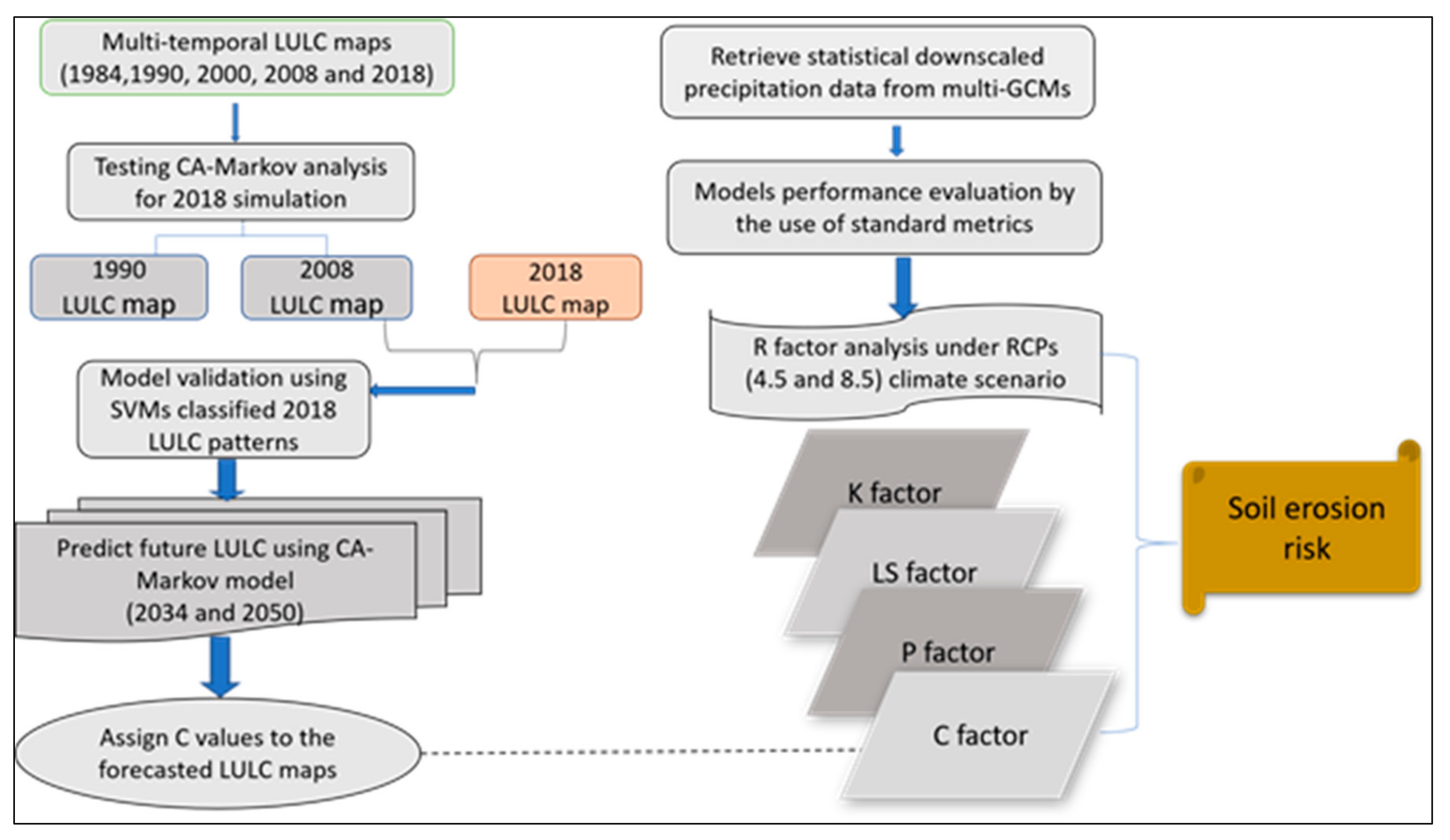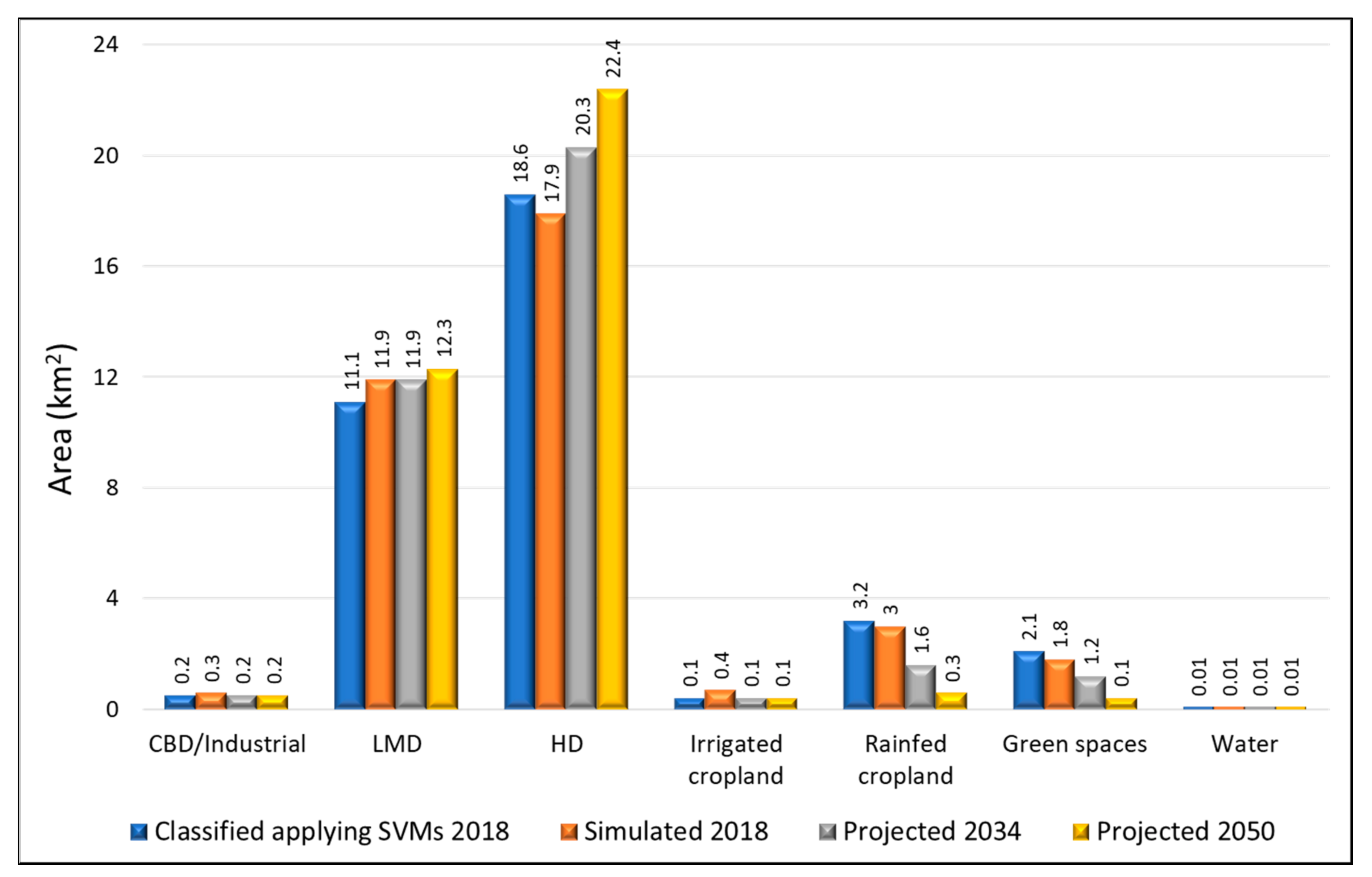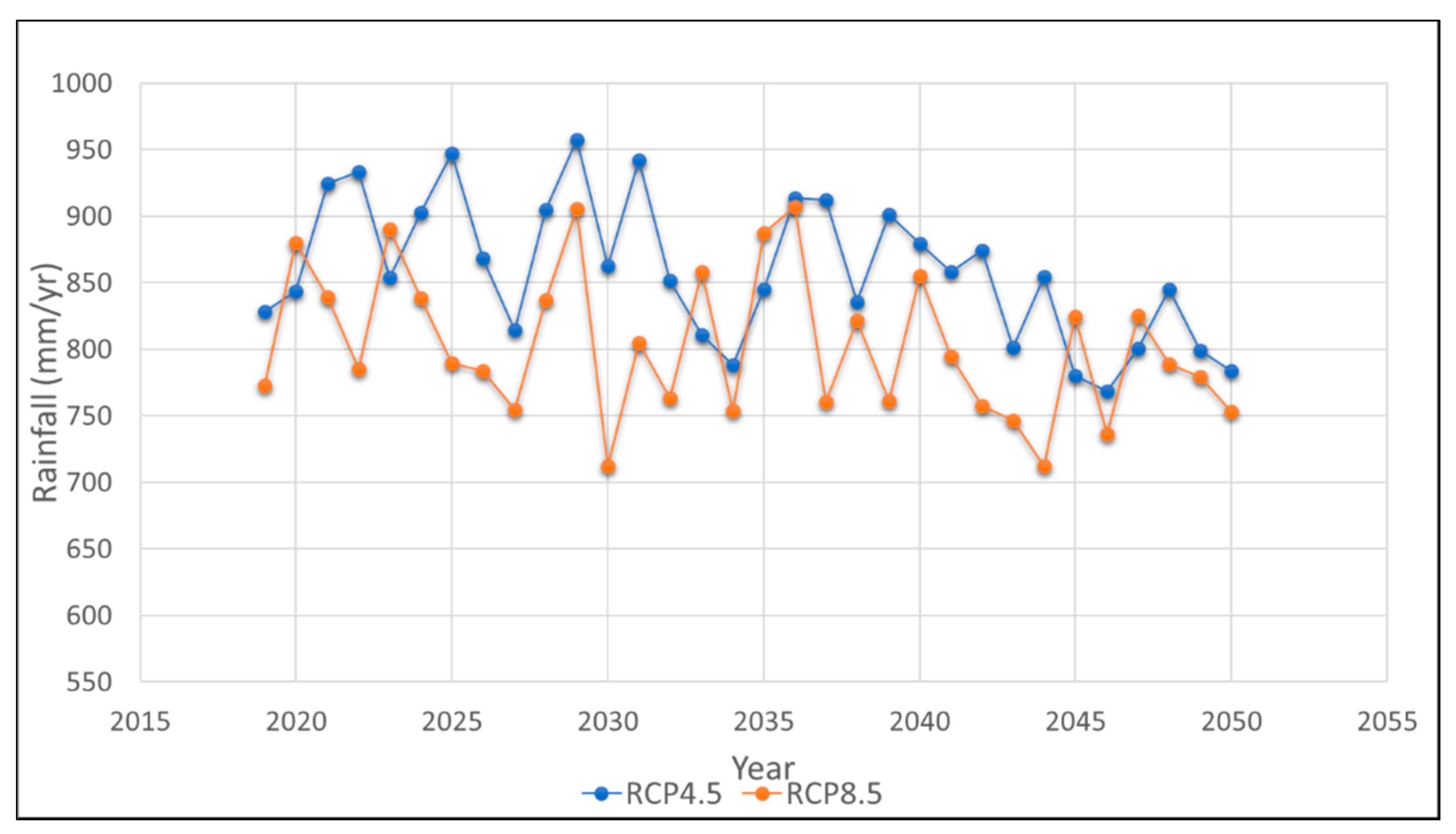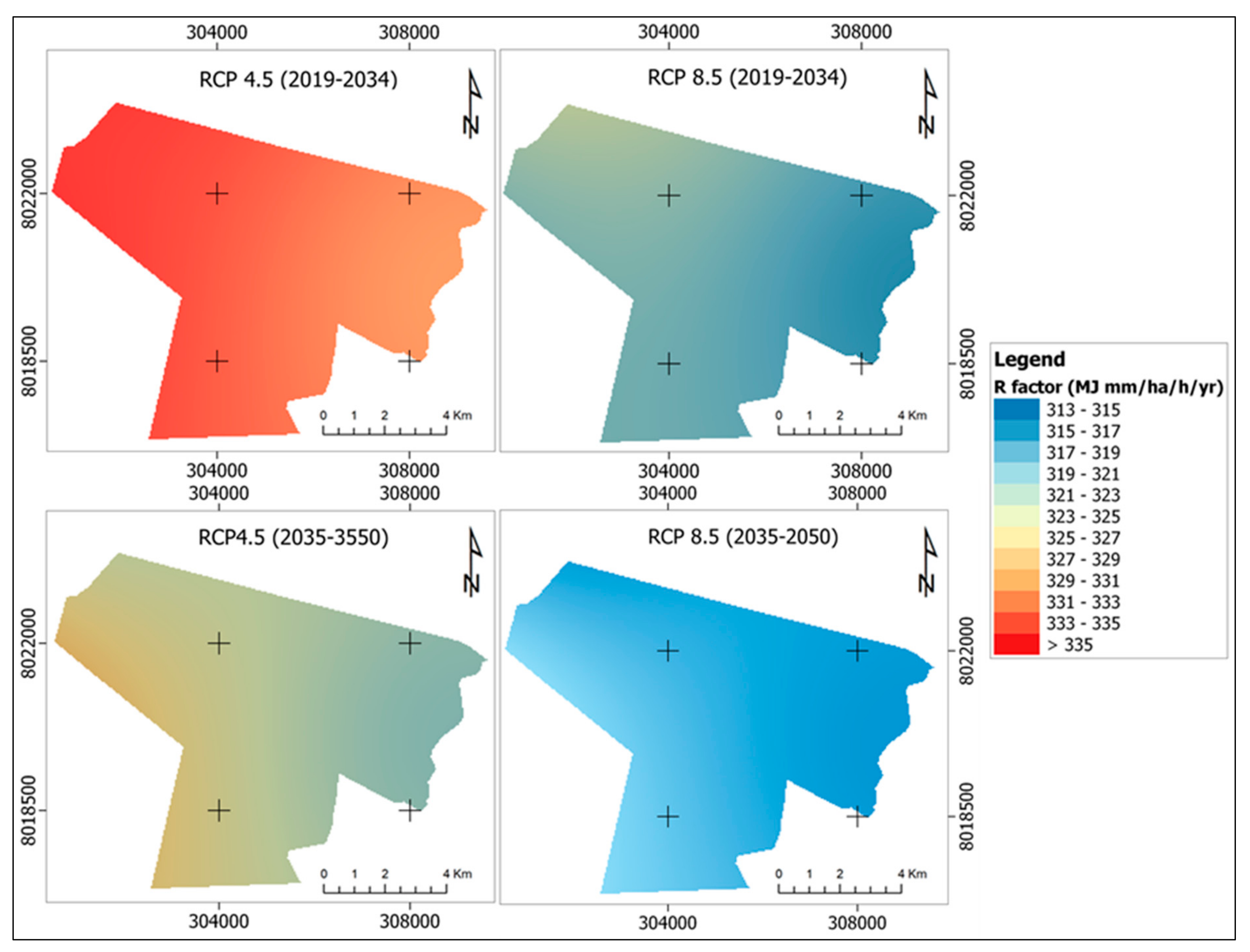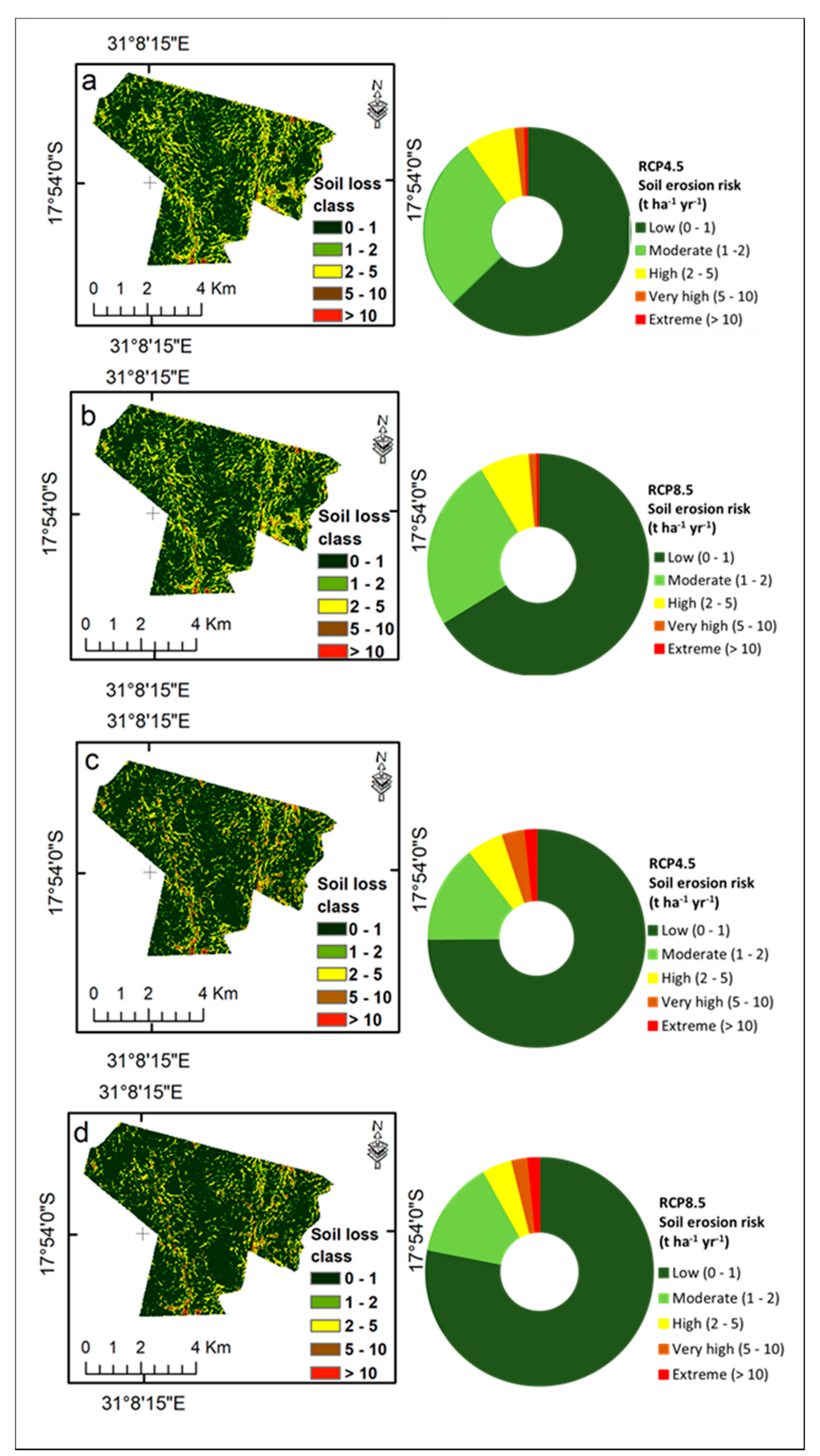1. Introduction
Soil erosion by water has become a global threat undermining environmental sustainability [
1]. This is attributed to various controlling factors related to Land Use and Land Cover (LULC) changes influenced by population growth, rising economic activities, unsustainable agricultural practices and climate change [
2,
3]. LULC change has been reviewed as one of the main driving forces of global environmental change, making it an important factor to assess at different spatio-temporal levels [
4,
5]. The LULC changes at both local and global levels are dynamic processes [
2] and their drivers correspond to complex systems with dependent characteristics and interactions having a wide array of implications for the future ecological balance and environmental sustainability. Urbanization, as one among the major drivers of LULC change, depends on population growth, migration and desires to change the current state of the Earth. These actions could be for the betterment of livelihoods and in turn could be detrimental to the environment and humankind [
6,
7]. The resulting ramifications include the modification of the landscape due to the sprawling of unplanned urban built-up areas, development of urban heat islands and over-exploitation of natural resources as direct impacts, and collateral land degradation, climate change, soil erosion and siltation [
7,
8,
9].
The United Nation’s World Urbanization Prospects reveal that the global urban population increased from about 30% in 1950 to approximately 54% in 2014, with almost 2.5 billion urban dwellers expected by 2050 [
10]. For India, approximately 50% of the population have been projected to be living in cities by 2050 as a result of rural–urban migration due to increased economic activities in the urban areas, which have become a strong pulling factor [
11]. Rapid urbanization in Africa has been reported due to population growth and it has been projected to almost triple by 2030 [
11]. However, according to information from the World Economic Forum, in 2020 56.2% of the global population already lived in cities [
12], with highly variable rates between regions, ranging from 81.2% urban dwellers in Latin America and the Caribbean to 43.5% in Africa [
13]. Breaking these data down to Zimbabwe, about a quarter of the country’s population lives in urban areas. Focusing on the case study of Epworth district, being part of the Harare Metropolitan Province, approximately 47% of the population increase was registered between 1992 and 2012 [
14], with a triplication of built-up areas from about 19.5% in 1984 to 61.3% in 2018 [
15]. Such trends in urban population growth directly impact the ecosystem of the urbanizing area, including the peri-urban area. This earmarks a gap which requires monitoring of the impacts driven by rampant LULC changes through urban expansion on the ecosystem as a basis to implement a proper spatial policy to enable effective decision-making processes [
16,
17]. This implies a rich understanding of the trends of urban expansion and development, and it requires the integration of spatially differentiated data, applying geomatics to quantify and predict future spatial distributions [
18,
19]. By the case study of the Epworth district in the Harare Metropolitan Province, it will be demonstrated that future land use models provide a valuable basis for foresight spatial planning to ensure environmental sustainability.
The LULC changes occurring at unprecedented levels threaten multiple ecological processes such as surface runoff, soil erosion, siltation and agricultural non-point source pollution, resulting in landscape degradation, habitat loss and inaccessibility to properties [
20,
21]. Focusing on sub-Saharan metropolitan areas, the example of the Harare Metropolitan Province documents a rapid transformation of urban agricultural land and shrub lands to built-up areas and other sealed settlement areas over the past decades [
9,
22]. For example, Epworth district, as part of the Harare Metropolitan Province, has witnessed an increase in built-up areas linked with high soil erosion risk due to increased impervious surfaces and construction activities which facilitate surface runoff [
23]. This results in accelerated soil loss in sensitive areas mostly within active built-up areas. The radical LULC changes in this area also include the loss of water bodies due to siltation resulting from sand mining and brick moulding along the river banks; encroachment of wetlands by construction activities; and grading of unpaved roads which later facilitate accelerated surface runoff due to compaction [
24].
Furthermore, climate change is reiterated to be heavily associated with locally increasing rainfall intensity, frequency and extent, resulting in increasing rainfall erosivity [
25]. The Fifth Assessment Report (AR5) of the IPCC (Intergovernmental Panel on Climate Change) highlights that global mean precipitation and surface temperatures have significantly changed with reference to observed changes between 1850 and 1900, and these changes are likely to continue to be experienced in the 21st century [
26]. Several studies point out that accelerated soil erosion by water due to climate change accentuates processes that alter soil physiochemical and biological properties [
27,
28,
29]. This entails the need to curb soil erosion through minimizing the removal of vegetation cover, improving surface roughness to facilitate infiltration capacity and reducing rainfall-runoff processes [
30]. Climate change also inevitably triggers a shift in land use, forcing the adoption of new management practices and planting new crops in order to mitigate detrimental impacts [
31,
32].
The sketched interrelations between LULC change and climate change and its possible environmental impacts emphasize the need to investigate future potential impacts of LULC change and climate change on potential soil erosion risks caused by water. For the coming decades, for wider areas, the increasing intensity of the hydrological cycle is projected by multiple global circulation models (GCMs), pronouncing more intense rainfall events that directly influence rainfall erosivity [
26]. We want to investigate these interrelations using the example of Epworth district, a fast-growing urban area of the Harare Metropolitan Province. Soil erosion by water has been repeatedly investigated in different regions of Zimbabwe, focusing on either catchments or arable areas [
33,
34,
35]. There is limited knowledge regarding estimated future soil loss rates and potential soil erosion risk in Zimbabwe as impacted by future climate change and land use changes, knowledge indispensable for future policy decision-making processes. The current study examines the potential future effects of land use change as well as of climate change on soil erosion risk. Overall, climate change scenarios as provided by the IPCC [
26] and forecasts of LULC change were applied for the assessment of future potential soil erosion risk for the years 2034 and 2050.
1.1. Modelling Land Use Changes in Urban Areas
Multiple studies on future soil erosion focus mainly on the dynamics of climate variables such as temperature and rainfall [
32,
36], while land use changes are rarely considered regardless of the high awareness of processes such as population growth, immigration and urbanization occurring at alarming rates. There is a wide range of spatial models able to simulate and predict land use changes based on the application of remote sensing techniques [
37,
38]. The spatial transition model and statistical description model are the two major models widely used for the assessment and monitoring of land use changes [
8,
37,
39]. Furthermore, the Markov chain model is widely applied to simulate urban growth due to its capability of quantifying land use changes, their trends and their dimensions [
9,
22,
40,
41,
42,
43]. Markov chain models correspond to stochastic processes [
44] that summarize changes by developing a transition probability matrix of land use change, indicating that the probability of a system being in one state at a given time can be determined if the state at an earlier period is known [
40,
45]. The Cellular Automata (CA) are simple and flexible dynamic spatial systems able to integrate complex urban systems in order to simulate future urban growth patterns [
46,
47,
48]. The CA are based on the supposition that land use change for any given location (grid cell) can be explained by its present state and the transformations in its neighbouring cells [
49]. Therefore, the inability of the Markov chain model to simulate spatial changes over time is superseded by integrating it into the CA to enhance the spatial predictive accuracy of the urban land use dynamics [
47,
50,
51,
52,
53].
Previous studies have adopted simulation models that apply GIS and remote sensing techniques for land use change modelling and monitoring of dynamic urban growth patterns [
40,
46,
50]. In the case of Harare Metropolitan Province, due to the dynamic nature of urban growth, some parts of its districts were simulated using the CA–Markov model in order to predict the impact of urban land use change on future microclimate [
9], while Sibanda and Ahmed [
52] predicted the future LULC and their impacts on wetland areas in the Shashe sub-catchment of Zimbabwe. According to Mushore et al. [
9], accelerated urban growth without the conservation of green spaces and adherence to mitigation policies contribute to locally increasing microclimate temperatures, causing thermal discomfort in urban areas. The CA–Markov model was also applied to project future LULC scenarios for Arasbaran biosphere reserve in Iran [
54]. Future LULC distribution patterns were also simulated with high accuracy using the CA–Markov model for Jordan’s Irbid governorate, with built-up areas predicted to increase from about 19.5% to approximately 64.6% between 2015 and 2050 [
55]. Due to the plausible outcomes, recommendations indicate that the CA–Markov model is an effective tool in monitoring and assessing future land use patterns for policy and decision-making processes [
40,
51,
52,
53].
1.2. Climate Change Emission Scenarios
The establishment of the Representative Concentration Pathways (RCPs) as future climate change mitigation scenarios followed a response call on the effectiveness of climate policy inclusion in future climate change modelling and research [
26,
56,
57]. The RCPs illustrate how the future climate may evolve, considering a range of variables which encompass socio-economic changes, technological advancement, energy, greenhouse gas emissions and land use changes [
26]. Most precipitation projections from GCMs have been widely used on land surface processes for the assessment of climate change impacts and adaptation [
1,
58,
59]. However, uncertainties in GCMs primarily exist on biases of raw outputs, resulting in either over or underestimation of climate variables due to erroneous assumptions in the model’s development [
60,
61]. As such, many studies have embarked on the use of multi-modelling techniques to minimize the uncertainty of future predictions in order to obtain plausible future projections [
62,
63,
64,
65,
66].
The climate change emission scenarios approximate radiative forcing levels of greenhouse gas concentrations, aerosols, and tropospheric ozone precursors by 2100 [
57]. The RCP8.5 scenario is characterized by increasing levels of greenhouse gas concentrations [
67]. Further, the RCP8.5 is a highly energy-intensive scenario attributed to high population growth and a lower rate of technology development; this is a scenario with little to no climate policy, making it possible to represent all future climatic possibilities [
26,
57]. For the RCP4.5 scenario, historical emissions and land cover information are integrated in order to follow a cost-effective pathway through stabilization of anthropogenic components to reach the target radiative forcing [
56,
68]. The RCP4.5 considers technological advances such as combining bioenergy production with CO
2 capture and geologic storage to enhance more energy production with negative carbon emissions [
68,
69].
4. Discussion
The predicted CA–Markov model results reveal an increase in the spatio-temporal pattern of built-up area, with built-up area expected to cover over 95% in 2050 from an approximated total of 84.5% in 2018 (
Figure 3,
Table 5). The forecasted results indicate that green spaces and croplands will continue to decline at the expense of built-up area (
Table 5). Thus, the transition probability matrices for different periods reveal the probability of each class (n) in the LULC maps changing in the next distinct period (t
n+1) in respect of the surrounding cells [
22,
81]. These predictions of built-up area growth at the expense of green spaces and croplands in the Harare Metropolitan Province concur with the conversion rates predicted by Mushore et al. [
9] using CA–Markov model analysis. The same analysis agrees with the predicted urban growth and the development of Irbid’s governorate of Jordan, with projected built-up area growth amounting to almost 65% in total area from an estimated 14.5% between 2015 and 2050, at the expense of vegetation and farmlands [
55]. Therefore, such developments indicate the core principle of the CA models, which stipulates that the present state of development is a continuation of historical changes induced by the neighbourhood interactions [
40,
49,
81]. This predicted expansion pattern is a result of the neighbourhood effect, which exhibits that the converted land use is next or close to the existing dominant land use, and predominantly built-up area exists for this scenario [
39,
47,
49].
The predicted loss of green spaces and croplands may result in the detrimental loss of urban agricultural land and areas of aesthetic value to the ecosystem, which provide environmental protection. With the escalating socioeconomic woes and poverty in the city [
70], the loss of urban agricultural land to urban development will leave many poorly resourced Epworth residents with detrimental food insecurities, threatening their livelihoods since many survive on market gardening and other urban farming activities [
125,
126]. The loss of green spaces also results in the reduction in vegetation cover and biomass which dissipates rainfall, reducing its direct impacts on the soil surface and facilitating percolation [
101]. Further, with the current economic meltdown and population growth, the surge of urban built-up area predicted by the CA–Markov model can be justified; the Epworth district will be no exception in terms of absorbing more inhabitants from other spheres of the Harare Metropolitan Province. This push could be exacerbated by unaffordable rental charges and cost of living in other affluent suburbs of the Harare Metropolitan Province, resulting in further densification and overcrowding in Epworth district. However, due to excessive demand for shelter and anticipated population growth, the conversion of croplands and green spaces to a built-up area will intensify impervious surfaces across the district [
15,
127].
The GCM ensembles were used to quantify the hydrological impacts of climate change under different climate scenarios, RCP4.5 and RCP8.5, to obtain reliable projections [
61,
65,
122,
128]. Based on statistical metrics, the evaluation of the performance showed that fourteen GCMs (
Table 10) have sufficient performance when evaluated with observations from Harare Metropolitan gauging stations (d > 0.7, r > 0.7 and R
2 > 0.5), with the exception of MRI-CGCM3, observed to have the lowest determination coefficient of 0.47. This may suggest that the general circulation model could have other specific years that were not properly simulated [
63]; however, the analysis shows that most GCMs displayed good simulation. Above all, the GCMs have an rRMSE below 20%, which is reasonably acceptable [
116,
117,
129]. Further, coarse grid resolutions from GCMs make it difficult to match, with few in situ observations which are not uniformly distributed attributed to increases in spatial variation and uncertainty to clearly define local precipitation characteristics, therefore increasing the simulation bias [
130,
131,
132].
For the RUSLE model, potential soil erosion risk maps were produced using the geostatistical ArcGIS package (raster calculator) to multiply the RUSLE factor maps (
Figure 6 and
Figure 7). The predicted potential soil erosion risk averaged at 1.2 t ha
−1 yr
−1 in 2034 and 1.1 t ha
−1 yr
−1 in 2050 for the RCP4.5 climate scenario, while 1.1 t ha
−1 yr
−1 and 1.0 t ha
−1 yr
−1 were the predicted averages for 2034 and 2050 for the RCP8.5 climate scenario. Meanwhile, studies on the influence of land use change or the impact of soil erosion risk on crop productivity indicated that a tolerable soil loss rate at 1 t ha
−1 yr
−1 was sustainable for the tropics [
95,
133,
134,
135]. Based on the slow rate of soil formation across the tropics, including Europe and America (<1 t ha
−1 yr
−1) [
95,
133,
136,
137], the sustainable soil loss tolerance at 1 t ha
−1 yr
−1 was considered across the entire Epworth district. The resulting arguments around the proposed 10 t ha
−1 yr
−1 as the estimated soil erosion tolerance threshold for tropical ecosystems showed that it was highly overestimated, considering threats to the landscape and impacts on crop productivity likely to occur at such a high risk threshold [
138]. Furthermore, other studies indicated that average soil loss rates of 5 t ha
−1 yr
−1 may be sustainable soil loss rates in the tropics [
139,
140]. Nevertheless, an estimated 1 t ha
−1 yr
−1 soil loss threshold subsisted for the current study and the predicted area-wide averages were unsustainable in that they slightly surpassed the recommended soil loss threshold, except for the RCP8.5 climate scenario in 2050. However, the slight notable deviation from the 1 t ha
−1 yr
−1 sustainable threshold can be justified as the averages fall within the applicable tolerable range of c.a 1.4 t ha
−1 yr
−1 proposed for some parts of the tropics, including America and Europe [
137]. Thus, the estimated soil loss tolerance threshold was used to describe a sustainable soil loss rate [
141].
The integrated average annual precipitation between 2019 and 2034, based on the climate scenario RCP4.5 results, shows high average annual soil loss rates ranging between 0 and 69.3 t ha
−1 yr
−1 and 0 and 62.4 t ha
−1 yr
−1 for the RCP8.5 climate scenario in 2034. In contrast, applying average annual precipitation between 2035 and 2050, the R factor-based values show a decline in soil loss rates for the year 2050 in both climate scenarios ranging between 0 and 48.9 t ha
−1 yr
−1 for RCP4.5 and 0 and 42.3 t ha
−1 yr
−1 for RCP8.5. However, these results show a continuous declining trend of soil loss rates when compared with the baseline period that applied the R factor based on the average annual precipitation data derived from in situ observations between 1984 and 2000 for Epworth district, estimating high soil erosion risk with average annual soil loss rates between 0 and 92.8 t ha
−1 yr
−1 in 2000 [
23]. In summary, the soil loss rates for both the RCP4.5 and RCP8.5 climate scenarios are observed to be decreasing in spatial coverage over the years 2034 and 2050. Regardless of the high rainfall erosivity predicted between 2019 and 2034 in comparison with soil loss rates estimated for the year 2000 [
23], it is revealed that land use changes, including the shrinking of croplands and disturbed shrublands, predominantly reduce the soil loss impact due to increases in impervious surfaces across the Epworth district.
The increasing potential soil erosion risk predicted for Epworth district along the channel networks has been attributed to the steep slopes along the streams in combination with massive impervious surfaces, resulting in the accumulation of overland flow [
142]. Correspondingly, high topographic factor values appear on valley flanks (
Figure 7), exposing surfaces to severe runoff and flooding resulting from the increased slope inclination and reduced infiltration capacity [
143,
144]. Displayed soil loss rates exceeding 1 t ha
−1 yr
−1 for Epworth district will be considered unsustainable [
95,
137], and therefore, the need for sound policy implementation to avoid detrimental environmental damage. Such estimates, as indicated in
Table 11, reveal that a larger proportion of the study area will be exposed to tolerable soil loss rates [
95,
133,
134]. Nevertheless, there is a predicted increase in soil erosion risk in vulnerable areas, mainly downslope and low-lying areas along the flanks of the channel networks [
23,
142,
145].
The study results predict that soil loss rates vary with precipitation and land use changes for all the climate scenarios. The results suggest that the soil erosion response with regard to climate change could be complex, as it varies with time and on a climate scenario basis [
25]. Consequently, the proportion of area exposed to high potential soil erosion risk with average soil loss rates between 2 and 5 t ha
−1 yr
−1 will markedly decline and most likely will even halve by 2050, as opposed to the doubling and triplicating proportional areas exposed to very high and extreme potential soil erosion risk for both climate scenarios in 2050. This is linked with the increasing vulnerability to smaller proportional area occupied by sparse green spaces and bare areas along channel networks. Such increasing trends in potential soil erosion risks are primarily accelerated by concentrated overland flow resulting from reduced infiltration processes across the Epworth district [
99,
143,
146]. This vulnerability and response to rainfall impact and runoff processes with regard to reduced spatial area exposed to direct soil displacement in 2050 underpins the effects of land use changes and sloping topography along the channel network [
114,
147].
The decreasing rainfall erosivity for both scenarios over time concurs with the future analysis that incorporated regional climate models (RCMs) by Hudson and Jones [
130], in which they highlighted the likelihood of increasing consecutive dry days in southern Africa; however, with some increases in other parts of the region [
148]. Additionally, interannual high rainfall intensity impact is relatively expressed as this would be masked in annual rainfall averages due to low rain-day frequency [
148]. The contraction of the rainfall season was projected following the observed late onset and early rainfall cessation in sub-Saharan Africa, mostly in central Mozambique, large parts of Botswana and the northern and southern parts of Zimbabwe [
148]. Such responses to climate change tally with the predicted decline in overall soil erosion risk in 2050, which, however, still require more robust regional analysis on precipitation uncertainties to global climate change [
130,
148,
149]. Nevertheless, the use of model ensemble averages could have limited the impact of other predicted extreme rainfall events [
61,
65,
122]. Such changes and manipulations of rainfall intensities could negatively impact the final soil erosion prediction outcome [
150,
151]. Furthermore, the use of coarse grid resolutions and numerical methods reduces models’ data independency, and therefore increases the bias and uncertainty range of the outcomes [
61,
122,
123]. The empirical RUSLE model is also limited only to the predictive capacity of sheet, inter-rill and rill soil erosion processes spanning over long periods, as it is not an event-based model, which also does not consider gullying erosion processes [
1,
93,
97,
152,
153]. Other data-driven processes integrated in the empirical RUSLE technique increase the uncertainty of future soil erosion risk due to varying data sources applied without rigorous quantification of their uncertainties and propagation [
1,
154].
Overall, high potential soil erosion risk displayed within the vicinity of Jacha river and tributaries extending from the north and southeast parts of the district draining southwards continue to increase, as predicted by the RUSLE model widely in 2050. This is attributed to the increasing sealed surface area and the sloping topography contributing to increased overland flow and surface runoff [
143,
155]. Taking into account human activities, previous studies reiterated that sand poaching activities along riverbanks are associated with heavy trucks ferrying sand to construction sites, contributing to high soil compaction on unpaved roads [
23,
24,
142], reducing the infiltration capacity, and hence increasing surface runoff processes. For Epworth district, activities such as sand poaching and extraction along the riverbanks will be inevitable due to the predicted built-up area expansion and due to the fact that for many locals, informal activities provide employment for the sustenance of their livelihoods. Therefore, there is a need to implement sound policies and sustainable environmental management approaches in order to curb environmental damage and the future extinction of water bodies and their ecosystem services. Uncertainties exist in this study about policy amendments regarding the functionality of the Local Boards and Authorities in regulating developmental plans. This, in turn, will affect LULC changes in the Epworth district of the Harare Metropolitan Province. However, this was held constant in the prediction of future LULC distribution patterns for Epworth district.
5. Conclusions
The study uses LULC distribution patterns between 1990 and 2008 to apply a Markov chain model which allows the development of a transition probability matrix and suitability maps, and later defines the complex dynamic spatial patterns of urban area by the flexible Cellular Automatons. The validation of the simulated 2018 LULC distribution patterns and the actual 2018 LULC map displayed strong spatial agreement, both quantitatively and through visual inspection. The strong agreement and consistency of the LULC spatial patterns from the cross validation displayed the reliability and usability of the CA–Markov model to predict 2034 and 2050 future LULC distribution patterns for Epworth district. The predicted findings show a continuous increase in urban built-up area over the years 2034 and 2050 at the expense of croplands and perturbed green spaces, predominantly with the expansion of high-density residential areas towards Epworth district peripheries.
Further, future potential soil erosion risk was predicted for the years 2034 and 2050 using the RUSLE model, which integrated R factors based on the average annual precipitation between 2019 and 2034 and 2035 and 2050, as provided by climate scenarios RCP4.5 and RCP8.5. The goodness of fit measures highlighted that the general circulation models (GCMs) are useful for the assessment of future soil erosion risk, following the evaluation of GCMs performance with gauged observations, which showed a good performance, ascertaining their feasibility. As such, ensemble average outcomes from multiple GCMs under both the RCP4.5 and RCP8.5 climate scenarios were incorporated in the regional statistical relations equation to derive the rainfall erosivity factor for use in the RUSLE model.
Future trends in climate variability reveal that the projected high rainfall for the RCP4.5 climate scenario between 2019 and 2050 compared to the RCP8.5 climate scenario will contribute to high localized soil erosion risk in vulnerable areas, including perturbed green spaces, agricultural land and stream banks. High soil loss rates were predicted in 2034 for both climate scenarios RCP4.5 and RCP8.5, in comparison with low soil loss rates in 2050 for both climate scenarios, and this is largely attributable to the predicted dynamic land use changes resulting in the reduction in surface area exposed to soil erosion processes over time. The predicted results also indicate that average annual soil loss rates will approximately halve in 2050 from an estimated 0–93 t ha−1 yr−1 in 2000, independent of whether the RCP4.5 or RCP8.5 climate scenario is applied. Nevertheless, for 2050, increasing soil erosion risks have been predicted along the flanks of the drainage networks.
Overall, this study highlights the application of the CA–Markov model in combination with the RUSLE model to derive useful simulations for predicting future LULC and soil erosion risk. In addition, based on the stipulated IPCC policy recommendations from the Fifth Assessment Report (AR5), governments and policy makers need to implement sound climate policies in order to curtail and curb environmental degradation and landscape fragmentation at the local scale.

